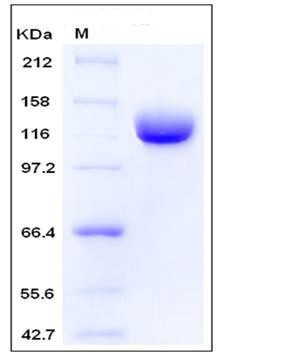Human ANPEP / CD13 Protein (603 Met/Ile, His Tag)
APN,CD13,GP150,LAP1,P150,PEPN
- 100ug (NPP1983) Please inquiry
| Catalog Number | P10051-H08H |
|---|---|
| Organism Species | Human |
| Host | Human Cells |
| Synonyms | APN,CD13,GP150,LAP1,P150,PEPN |
| Molecular Weight | The recombinant human ANPEP protein consists of 910 amino acids and has a predicted molecular mass of 104.2 kDa. In SDS-PAGE under reducing conditions, the apparent molecular mass of rhANPEP is approximately 135-140 kDa due to glycosylation. |
| predicted N | Lys 69 |
| SDS-PAGE |  |
| Purity | > 97 % as determined by SDS-PAGE |
| Protein Construction | A DNA sequence encoding the metalloprotease domain (Lys 69-Lys 967,603 Met/Ile) of the mature form of human ANPEP (NP_001141.2) was expressed with N-terminal signal peptide and C-terminal polyhistidine tag. |
| Bio-activity | Measured by its ability to cleave the fluorogenic peptide substrate, Ala-7-amido-4-methylcoumarin (Ala-AMC) . The specific activity is >2,500 pmoles/min/μg. |
| Research Area | Cardiovascular |Blood |Serum Protein |
| Formulation | Lyophilized from sterile PBS, pH 7.3 1. Normally 5 % - 8 % trehalose and mannitol are added as protectants before lyophilization. Specific concentrations are included in the hardcopy of COA. |
| Background | Aminopeptidase N (ANPEP or APN), also known as CD13, is a cell-surface metalloprotease located in the small-intestinal and renal microvillar membrane, as well as other plasma membranes. It belongs to the peptidase M1 family. CD13 plays a role in the final digestion of peptides generated from hydrolysis of proteins by gastric and pancreatic proteases and is involved in the metabolism of regulatory peptides by diverse cell types. CD13/APN is a potent regulator of angiogenesis which is essential for tumor invasion and metastasis, and its transcription in activated endothelial cells is induced by angiogenic growth factors via the RAS/MAPK pathway. In addition, this enzyme has been shown to participate in antigen processing and presentation, and accordingly, defects in this gene appear to be a cause of various types of leukemia or lymphoma and carcinomas. |
| Reference |
